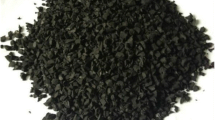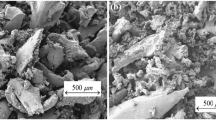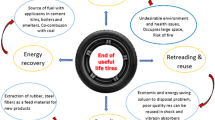Abstract
More than 1.5 billion tires are produced worldwide per year. This causes environmental pollution in the nature. Studies have shown that scrap tire rubbers can be used as aggregates in concrete mixtures and as modifiers in bituminous composites. Various studies were conducted for this reason and reported in the literature. The present study has been undertaken to examine the microstructure properties of rubberized asphalt and cement-based composites. Results showed that adhesion between rubber particles and cement matrix is significant for the final product properties. Also the physical and mechanical properties of asphalt composites can be improved with the addition of waste rubber into the mixture.















Similar content being viewed by others
References
Statistical summary of world rubber situation (2013) http://www.rubberstudy.com/documents/WebSiteData_2.0.pdf. Accessed 02 March 2014
Karger-Kocsis J, Mészáros L, Bárány T (2013) Ground tyre rubber (GTR) in thermoplastics, thermosets and rubbers. J Mater Sci 48:1–38. doi:10.1007/s10853-12-6564-2
Rubber Manufacturers Association (2013) US scrap tire management summary 2005–2009. Washington
The recycling industry: a global view (2003) http://www.irevna.com/pdf/Industry%20report.pdf. Accessed 15 February 2014
Nehdi M, Khan A (2001) Cementitious composites containing recycled tire rubber: an overview of engineering properties and potential application. Cem Concr Aggr 23:3–10. doi:10.1520/CCA10519J
Meyer C (2009) The greening of the concrete industry. Cem Concr Comp 31:601–605. doi:10.1016/j.cemconcomp.2008.12.010
Reschner K (2008) Scrap tire recycling. A summary of prevalent disposal and recycling methods. Entire-Engineering, Berlin
Tantala MW, Lepore JA, Zandi I (1996) Quasi-elastic behavior of rubber included concrete. In: 12th international conference on solid waste technology and management, Philadelphia, PA
Siddique R, Naik TR (2004) Properties of concrete containing scrap-tire rubber—an overview. Waste Manag 24:563–569. doi:10.1016/j.wasman.2004.01.006
Ye Z, Kong X, Yu J, Wei L (2003) Microstructure and properties of desulfurized crumb rubber modified bitumen. J Wuhan Univ Tech Mater Sci Ed 18:83–85. doi:10.1007/BF02835097
Paul J (1985) Encyclopedia of polymer science and engineering. 14:787–802
Siddique R (2008) Waste materials and by-products in concrete. Springer, Berlin
Sunthonpagasit N, Duffey MR (2004) Scrap tires to crumb rubber: feasibility analysis for processing facilities. Resour Conser Recycl 40:281–299. doi:10.1016/S0921-3449(03)00073-9
Shu X, Huang B (2013) Recycling of waste tire rubber in asphalt and Portland cement concrete: an overview. Constr Build Mater. doi:10.1016/j.conbuildmat.2013.11.027
Diaconescu RM, Barbuta M, Harja M (2013) Prediction of properties of polymer concrete composite with tire rubber using neural networks. Mater Sci Eng B 178:1259–1267. doi:10.1016/j.mseb.2013.01.014
Suparat T (2013) Waste tyre management in Thailand: a material flow analysis approach. Dissertation, Asian Institute of Technology, Thailand
Nakao Y, Yamamoto K (2002) Waste tire and its collection systems. In: Nippon Steel technical report no. 86
Huynh H, Raghavan D (1997) Durability of simulated shredded rubber tire in highly alkaline environments. Adv Cem Bas Mater 6:138–143. doi:10.1016/S1065-7355(97)90021-3
Lo Presti D (2013) Recycled tyre rubber modified bitumens for road asphalt mixtures: a literature review. Con Build Mat 49:863–881. doi:10.1016/j.conbuildmat.2013.09.007
Epps JA (1994) Use of recycled tires in highways. Synthesis of Highway Practice 198, Transportation Research Board, National Research Council, Washington
Khatib ZK, Bayomy FM (1999) Rubberized Portland cement concrete. ASCE J Mater Civ Eng 11:206–213. doi:10.1061/(ASCE)0899-1561(1999)11:3(206
Huang B, Li G, Pang S, Eggers J (2004) Investigation into waste tire rubber-filled concrete. ASCE J Mater Civ Eng 16:187–194. doi:10.1061/(ASCE)0899-1561(2004)16:3(187
Lo Presti D, Airey G, Partal P (2012) Manufacturing terminal and field bitumen-tyre rubber blends: the importance of processing conditions. Pro Soc Behav Sci 53:485–494. doi:10.1016/j.sbspro.2012.09.899
Adams C, Amos AD, Shuler S (1985) Asphalt rubber binder laboratory performance. Report FHWA/TX-8571, 347-1F, Department of Highways and Public Transportation, Texas
Wu S, Ye Q, Li N (2008) Investigation of rheological and fatigue properties of asphalt mixtures containing polyester fibers. Constr Build Mater 22:2111–2115. doi:10.1016/j.conbuildmat.2007.07.018
Rodriguez Alloza AM, Gallego J, Pérez I, Bonati A, Giuliani F (2014) High and low temperature properties of crumb rubber modified binders containing warm mix asphalt additives. Constr Build Mater 53:460–466. doi:10.1016/j.conbuildmat.2013.12.026
Fedroff D, Ahmad S, Savas BZ (1996) Mechanical properties of concrete with ground waste tire rubber. Trans Res Rec 1532:66–72. doi:10.3141/1532-10
Liu H, Chen Z, Wang W, Wang H, Hao P (2013) Investigation of the rheological modification mechanism of crumb rubber modified asphalt (CRMA) containing TOR additive. Constr Build Mater. doi:10.1016/j.conbuildmat.2013.11.031
Seo Kim H, Geiger A, Amirkhanian SN, Soon Park T, Woo Kim K (2008) Effects of asphalt ratios on properties of crumb rubber modified asphalts. In: Proceedings of the 6th international conference on road and airfield pavement technology, Sapporo Japan
Abdelrahman MA, Carpenter SH (1998) Controlling low temperature properties of asphalt rubber binders. In: Proceedings of the 2nd transportation specialty conference, Canadian Society of Civil Engineering, Halifax, Nova Scotia, Canada
Hernández-Olivares F, Barluenga G (2004) Fire performance of recycled rubber-filled high-strength concrete. Cem Concr Res 34:109–117. doi:10.1016/S0008-8846(03)00253-9
Ganjian E, Khorami M, Maghsoudi A (2009) Scrap-tire-rubber replacement for aggregate and filler in concrete. Constr Build Mater 23:1828–1836. doi:10.1016/j.conbuildmat.2008.09.020
Bravo M, De Brito J (2012) Concrete made with used tyre aggregate: durability-related performance. J Clean Prod 25:42–50. doi:10.1016/j.jclepro.2011.11.066
Ali NA, Amos AD, Roberts M (1993) Use of ground rubber tires in portland cement concrete. In: Proceedings of the international conference on concrete 2000, University of Dundee, Scotland, p 379–390
Rostami H, Lepore J, Silverstraim T, Zundi I (1993) Use of recycled tires in concrete. In: International conference on concrete 2000, University of Dundee, Scotland, p 391–399
Eldin NN, Senouci AB (1993) Rubber-tire particles as concrete aggregates. ASCE J Mater Civ Eng 5:478–496. doi:10.1061/(ASCE)0899-1561(1993)5:4(478
Topçu İB (1995) The properties of rubberized concrete. Cem Concr Res 25:304–310. doi:10.1016/0008-8846(95)00014-3
De Brito J, Saikia N (2013) Recycled aggregate in concrete: use of industrial, construction and demolition waste. Springer, London
Topçu İB, Avcular N (1997) Analyses of rubberized concrete as a composite material. Cem Concr Res 27:1135–1139. doi:10.1016/S0008-8846(97)00115-4
Topçu İB (1997) Assessment of the brittleness index of rubberized concretes. Cem Concr Res 27:177–183. doi:10.1016/S0008-8846(96)00199-8
Liu F, Zheng W, Li L, Feng W, Ning G (2013) Mechanical and fatigue performance of rubber concrete. Constr Build Mater 47:711–719. doi:10.1016/j.conbuildmat.2013.05.055
Toutanji HA (1996) The use of rubber tire particles in concrete to replace mineral aggregates. Cem Concr Comp 18:135–139. doi:10.1016/0958-9465(95)00010-0
Ho AC, Turatsinze A, Hameed R, Vu DC (2012) Effects of rubber aggregates from grinded used tyres on the concrete resistance to cracking. J Clean Prod 23:209–215. doi:10.1016/j.jclepro.2011.09.016
Khaloo AR, Dehestani M, Rahmatabadi P (2008) Mechanical properties of concrete containing a high volume of tire-rubber particles. Waste Manag 28:2472–2482. doi:10.1016/j.wasman.2008.01.015
Issa CA, Salem G (2013) Utilization of recycled crumb rubber as fine aggregates in concrete mix design. Constr Build Mater 42:48–52. doi:10.1016/j.conbuildmat.2012.12.054
Segre N, Joekes I (2000) Use of tire rubber particles and addition to cement paste. Cem Concr Res 30:1421–1425. doi:10.1016/S0008-8846(00)00373-2
Raghavan D, Huynh H, Ferraris CF (1998) Workability, mechanical properties and chemical stability of a recycled tyre rubber filled cementitious composite. J Mater Sci 33:1745–1752. doi:10.1023/A:1004372414475
Mehta PK, Gjorv OE (1982) Properties of portland cement concrete containing fly ash and condensed silica fume. Cem Concr Res 12:587–595. doi:10.1016/0008-8846(82)90019-9
Huang B, Shu X, Cao J (2013) A two-staged surface treatment to improve properties of rubber modified cement composites. Constr Build Mater 40:270–274. doi:10.1016/j.conbuildmat.2012.11.014
Güneyisi E, Gesoğlu M, Özturan T (2004) Properties of rubberized concretes containing silica fume. Cem Concr Res 34:2309–2317. doi:10.1016/j.cemconres.2004.04.005
Pelisser F, Zavarise N, Longo TA, Bernardin AM (2011) Concrete made with recycled tire rubber: effect of alkaline activation and silica fume addition. J Clean Prod 19:757–763. doi:10.1016/j.jclepro.2010.11.014
Navarro FJ, Partal P, Boza FM, Valencia C, Gallegos C (2002) Rheological characteristics of ground tire rubber-modified bitumens. Chem Eng J 89:53–61. doi:10.1016/S1385-8947(02)00023-2
Moro FJL, Moro MC, Olivares FH, Schultz BW, Fernández MA (2013) Microscopic analysis of the interaction between crumb rubber and bitumen in asphalt mixtures using the dry process. Constr Build Mater 48:691–699. doi:10.1016/j.conbuildmat.2013.07.041
Xiang L, Cheng J, Que G (2009) Microstructure and performance of crumb rubber modified asphalt. Constr Build Mater 23:3586–3590. doi:10.1016/j.conbuildmat.2009.06.038
Albano C, Camacho N, Reyes C, Feliu JL, Hernández M (2005) Influence of scrap rubber addition to portland I concrete composites: destructive and non-destructive testing. Comp Struct 71:439–446. doi:10.1016/j.compstruct.2005.09.037
Turatsinze A (2005) Mechanical characterization of cement-based mortar incorporating rubber aggregates from recycled worn tyres. Build Environ 40:221–226. doi:10.1016/j.buildenv.2004.05.012
Bignozzi MC, Sandrolini F (2006) Tyre rubber waste recycling in self-compacting concrete. Cem Concr Res 36:735–739. doi:10.1016/j.cemconres.2005.12.011
Turki M, Bretagne E, Rouis MJ, Quéneudec M (2009) Microstructure, physical and mechanical properties of mortar-rubber aggregates mixtures. Constr Build Mater 23:2715–2722. doi:10.1016/j.conbuildmat.2008.12.019
Li G, Stubblefield MA, Garrick G, Eggers J, Abadie C, Huang B (2004) Development of waste tire modified concrete. Cem Concr Res 34:2283–2289. doi:10.1016/j.cemconres.2004.04.013
Li Z, Li F, Li JS (1998) Properties of concrete incorporating rubber tyre particles. Mag Concr Res 50:297–304. doi:10.1680/macr.1998.50.4.297
Shen W, Shan L, Zhang T, Ma H, Cai Z, Shi H (2013) Investigation on polymer-rubber aggregate modified porous concrete. Constr Build Mater 38:667–674. doi:10.1016/j.conbuildmat.2012.09.006
Chou LH, Yang CK, Lee MT, Shu CC (2010) Effects of partial oxidation of crumb rubber on properties of rubberized mortar. Comp Part B 41:613–616. doi:10.1016/j.compositesb.2010.09.009
Benazzouk A, Douzane O, Langlet T, Mezreb K, Roucoult JM, Quéneudec M (2007) Physico-mechanical properties and water absorbtion of cement composite containing shredded rubber wastes. Cem Concr Comp 29:732–740. doi:10.1016/j.cemconcomp.2007.07.001
Benazzouk A, Douzane O, Quéneudec M (2004) Transport of fluids in cement-rubber composites. Cem Concr Comp 26:21–29. doi:10.1016/S0958-9465(02)00119-1
Isayev AI (2013) Recycling of rubbers. In: The science and technology of rubber, 4th edn, Chapter 15, Elsevier, pp 697–764
Torgal FP, Ding Y, Jalali S (2012) Properties and durability of concrete containing polymeric wastes (tyre rubber and polyethylene terephthalate bottles): an overview. Constr Build Mater 30:714–724. doi:10.1016/j.conbuildmat.2011.11.047
Reda Taha MM, El-Dieb AS, Abd El-Wahab MA, Abdel Hameed ME (2008) Mechanical, fracture, and microstructural investigations of rubber concrete. J Mater Civ Eng 20:640–649. doi:10.1061/(ASCE)0899-1561(2008)20:10(640
Hernández Oliveras F, Barluenga G, Bollati M, Witoszek B (2002) Static and dynamic behavior of recycled tyre rubber-filled concrete. Cem Concr Res 32:1587–1596. doi:10.1016/S0008-8846(02)00833-5
Holmes N, Dunne K, O’Donnell J (2014) Longitudinal shear resistance of composite slabs containing crumb rubber in concrete toppings. Constr Build Mater 55:365–378. doi:10.1016/j.conbuildmat.2014.01.046
Segre N, Ostertag C, Monteiro P (2006) Effect of tire rubber particles on crack propagation in cement paste. Mater Res 9:311–320. doi:10.1590/S1516-14392006000300011
Author information
Authors and Affiliations
Corresponding author
Rights and permissions
About this article
Cite this article
Karakurt, C. Microstructure properties of waste tire rubber composites: an overview. J Mater Cycles Waste Manag 17, 422–433 (2015). https://doi.org/10.1007/s10163-014-0263-9
Received:
Accepted:
Published:
Issue Date:
DOI: https://doi.org/10.1007/s10163-014-0263-9




